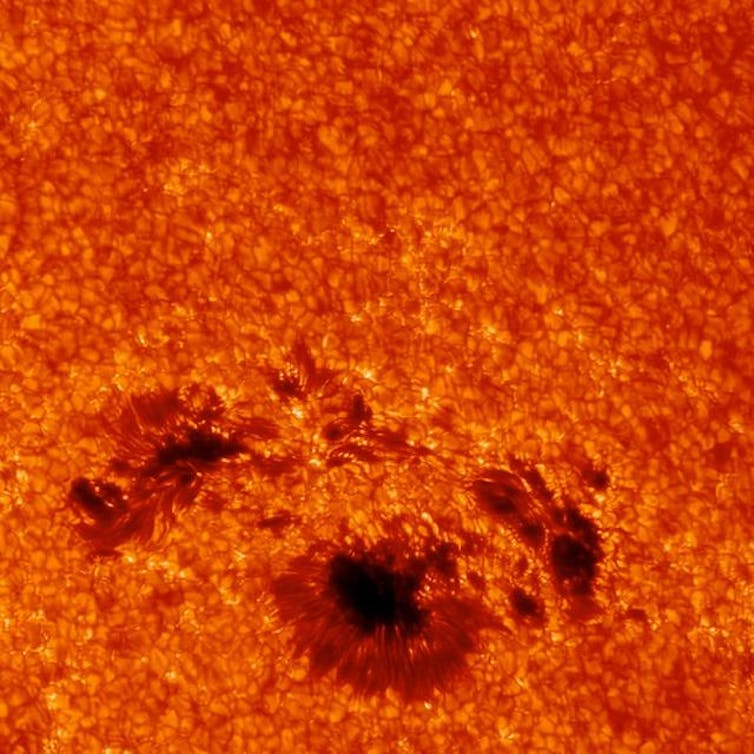Since ancient times, the sun has been known as a giver of light and heat, a source of life. Plants are coaxed from the Earth by its rays, bringing spring, followed by bountiful harvests.
The Earth itself was found to have mystical properties when lore from China spread the use of compass magnets to find the north direction. In 1600, after centuries of western compass use, William Gilbert, Queen Elizabeth I’s personal physician, produced a book about magnets that also described the whole Earth as one.
American astrophysicist George Ellery Hale gained fame by building the largest telescope in the world in the mid-20th century. Hale started his career studying the sun, and using polarized light, he showed that certain areas of the sun were highly magnetic, with fields thousands of times stronger than Earth’s. This magnetism was strongest in dark regions called sunspots.

(NASA Goddard)
In the 17th century, Galileo used the newly developed telescope to reveal that the sun was blemished with spots. He observed many of their properties, including that they showed the sun to rotate each month, and that their size changed over time. Although Galileo conducted some experiments with magnets in the form of lodestones used as crude compasses, he certainly did not make a connection to sunspots.
Observed changes
Sunspots captured astronomers’ interest, and with the expanding availability and quality of telescopes, were closely tracked until 1645. Despite huge interest in them, astronomers could find no sunspots for a 70-year period known as the Maunder minimum.
Then, in 1715, they mysteriously started to appear again. In the period since, sunspots have come and gone on a cycle that appears to be about 11 years long, referred to as the solar cycle, with the number of sunspots varying between zero and hundreds. Until 1859, attempts to explain solar cycles by linking them with other cyclical phenomena would have been classed as astrological, envisaging a connection between the heavens and Earth that is not real.
In 1859, Richard Carrington, a wealthy brewery owner and amateur astronomer, was sketching sunspots when, to his amazement, one turned abruptly from darkness to light.
This explosive “solar flare” lasted only a few minutes, but within two days was followed by a huge auroral and magnetic storm referred to as the Carrington Event. Auroras, normally restricted to near-polar latitudes, were seen worldwide. The technology of the day was affected, with telegraph systems running without their batteries or bursting into flames.
It is debated what the effects of a similar event would be on our modern technology, since there haven’t been any of that magnitude since. However, it was not immediately clear in 1859 that the sun and Earth really could be linked, and many thought that the solar flare and later storm were only coincidentally related.

(G. E. Hale)
Effects of solar magnetism
Hale’s discovery of solar magnetism about 50 years after the Carrington event, along with records showing that auroras had an 11-year cycle similar to that of the sun, formed the basis of our modern understanding of the “solar-terrestrial relationship.”
That relationship is fundamentally based on magnetism. Sunspots themselves store magnetic energy; its pressure allows sunspots to be cooler than the adjacent areas of the sun’s light-emitting surface or photosphere, and thus darker.
Under the right conditions, the magnetic energy can be released in various forms. White light flares like Carrington saw are very rare — more often the magnetic energy is converted to X-rays.
Gravity near the solar surface is about 30 times stronger than that on Earth, so any motion generated by flares rarely escapes from there. Instead, regions above the sunspots can succeed in shooting huge clouds of gas into space called “coronal mass ejections.” If, by chance, one is shot in the direction of our planet, it may cause auroral storms.

(Space Weather Prediction Center, NOAA)
If the magnetism of the active region around the sunspot creates a gas cloud that reaches Earth with a magnetic direction opposite to that discovered by Gilbert in 1600, energy can pour into the near-Earth region. This energy is stored on the nightside, not on the side facing the sun that it came from, and causes auroras.
If the magnetic direction does not align, there may be some compression due to the hot, fast gas cloud, but little else. Right now, we are at or near an unexpectedly large peak in the sunspot number and chances are we will continue to get large magnetic storms like that of May 2024 for possibly as much as a couple of years.
Beauty and danger combine in these events, but they are sure to fascinate.
